247 scholarly books by University Press of New England and 24
start with B
247 scholarly books by University Press of New England and 24
247 scholarly books by University Press of New England
24 start with B start with B
24 start with B start with B
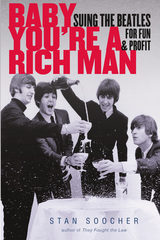
Baby You're a Rich Man
Suing the Beatles for Fun and Profit
Stan Soocher
University Press of New England, 2015
The Beatles, the most popular, influential, and important band of all time, have been the subject of countless books of biography, photography, analysis, history, and conjecture. But this long and winding road has produced nothing like Baby You’re a Rich Man, the first book devoted to the cascade of legal actions engulfing the band, from the earliest days of the loveable mop-heads to their present prickly twilight of cultural sainthood. Part Beatles history, part legal thriller, Baby You’re a Rich Man begins in the era when manager Brian Epstein opened the Pandora’s box of rock ’n’ roll merchandising, making a hash of the band’s licensing and inviting multiple lawsuits in the United States and the United Kingdom. The band’s long breakup period, from 1969 to 1971, provides a backdrop to the Machiavellian grasping of new manager Allen Klein, who unleashed a blizzard of suits and legal motions to take control of the band, their music, and Apple Records. Unsavory mob associate Morris Levy first sued John Lennon for copyright infringement over “Come Together,” then sued him again for not making a record for him. Phil Spector, hired to record a Lennon solo album, walked off with the master tapes and held them for a king’s ransom. And from 1972 to 1975, Lennon was the target of a deportation campaign personally spearheaded by key aides of President Nixon (caught on tape with a drug-addled Elvis Presley) that wound endlessly through the courts. In Baby You’re a Rich Man, Stan Soocher ties the Beatles’ ongoing legal troubles to some of their most enduring songs. What emerges is a stirring portrait of immense creative talent thriving under the pressures of ill will, harassment, and greed. Praise for They Fought the Law: Rock Music Goes to Court “Stan Soocher not only ably translates the legalese but makes both the plaintiffs and defendants engrossingly human. Mandatory reading for every artist who tends to skip his contract’s fine print.”—Entertainment Weekly
[more]
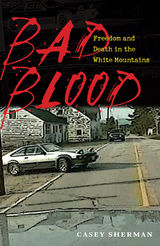
Bad Blood
Freedom and Death in the White Mountains
Casey Sherman
University Press of New England, 2012
In the shadow of the fallen Old Man of the Mountain, on a lonely stretch of mountain road, two men lay dead. A spasm of violence that took only a few minutes to play out leaves a community divided and searching for answers. From the author of newly released Boston Strong: A City’s Triumph Over Tragedy, about the 2013 Boston Marathon bombings, Bad Blood is the riveting account of the long-standing feud between Franconia, New Hampshire, police officer Bruce McKay, 48, and Liko Kenney, 24. In May 2007, Kenney shot and killed Officer McKay, following a dramatic chase that began with a routine traffic stop. Kenney, cousin of ski legend Bode Miller, was then shot and killed by a shadowy passerby. Almost immediately, the tragic incident revealed deep tensions within this otherwise quiet community in the White Mountains with charges that Kenney was a hell-raiser and mentally unstable and counter-charges that Officer McKay was a rogue cop who dispensed justice as a way to settle personal scores. Striving to get at the truth of the story, the author uncovers a complicated mix of personalities and motivations. Local and statewide interests clash while regional and national media— and even YouTube viewers— supply ready stereotypes to fit their agendas. Amid larger questions of the meaning of individual freedom we are, ultimately, helpless witnesses to an inevitable clash of characters.
[more]
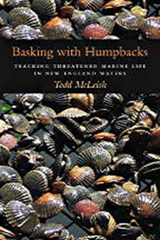
Basking with Humpbacks
Tracking Threatened Marine Life in New England Waters
Todd McLeish
University Press of New England, 2016
Basking with Humpbacks offers an exciting, close-up look at some of the most rare marine creatures living in New England waters and examines the complex threats they face. In eleven chapters, each featuring a different animal or plant, McLeish takes readers on an entertaining journey with scientists who study these species. The author follows basking sharks—the second largest fish in the sea—in their hunt for food, helps harbor porpoises escape from fishing nets, snorkels in search of wild bay scallops, and learns how the blood of horseshoe crabs is used in medical research. Along the way he visits the islands where rare seabirds nest, tracks humpback whales on their long migration to the Gulf of Maine, and watches as stranded leatherback turtles are returned to the ocean. These first-person experiences are coupled with interviews with biologists and other experts who explain in their own words the important role these creatures play in the marine ecosystem and what steps must be taken to protect them. In examining the natural history of selected plants and animals, McLeish also discusses the physics of waves and currents, the geology of the seabed, the chemistry of sea water, and other natural factors that influence the survival of New England marine life.
[more]

Battered Women In The Courtroom
The Power of Judicial Responses
Ptacek
University Press of New England, 1999
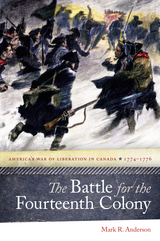
The Battle for the Fourteenth Colony
America’s War of Liberation in Canada, 1774–1776
Mark R. Anderson
University Press of New England, 2013
In this dramatic retelling of one of history’s great “what-ifs,” Mark R. Anderson examines the American colonies’ campaign to bring Quebec into the Continental confederation and free the Canadians from British “tyranny.” This significant reassessment of a little-studied campaign examines developments on both sides of the border that rapidly proceeded from peaceful diplomatic overtures to a sizable armed intervention. The military narrative encompasses Richard Montgomery’s plodding initial operations, Canadian partisan cooperation with officers like Ethan Allen, and the harrowing experiences of Benedict Arnold’s Kennebec expedition, as well as the sudden collapse of British defenses that secured the bulk of the province for the rebel cause. The book provides new insight into both Montgomery’s tragic Québec City defeat and a small but highly significant loyalist uprising in the rural northern parishes that was suppressed by Arnold and his Canadian patriot allies. Anderson closely examines the evolving relationships between occupiers and occupied, showing how rapidly changing circumstances variously fostered cooperation and encouraged resistance among different Canadian elements. The book homes in on the key political and military factors that ultimately doomed America’s first foreign war of liberation and resulted in the Continental Army’s decisive expulsion from Canada on the eve of the Declaration of Independence. The first full treatment of this fascinating chapter in Revolutionary War history in over a century, Anderson’s account is especially revealing in its presentation of contentious British rule in Quebec, and of Continental beliefs that Canadiens would greet the soldiers as liberators and allies in a common fight against the British yoke. This thoroughly researched and action-packed history will appeal to American and Canadian history buffs and military experts alike.
[more]
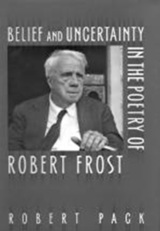
Belief and Uncertainty in the Poetry of Robert Frost
Robert Pack
University Press of New England, 2004
Robert Pack’s lifelong delight in Robert Frost's intricate, beautiful, and profound poetry shines through in the essays in this book. He confronts such broad themes as mourning, inheritance, nature, and the imagination, bringing to bear historical, psychological, Darwinian, and close-textual-reading interpretive approaches. Chapter one sets Frost’s work in the tradition of nature writing, from the Book of Genesis through modern American ecological works. Chapter two examines the profound influences of the Book of Job, Darwin, and evolutionary theory on Frost’s thinking. There follow chapters that structurally and philosophically compare Wordsworth’s “Michael” to Frost’s “Wild Grapes,” focusing on the themes of inheritance, grieving, and the potency of the imagination. The reader encounters Frost as teacher and preacher, Frost’s idea of how beliefs are affirmed, the simultaneous representation of adult memory and immediate childhood sensation, and the underlying duality of place and nothingness, which forms the existential background for his “stay against confusion”—the consoling purpose of Frost's poetic art.
[more]
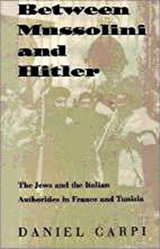
Between Mussolini and Hitler
The Jews and the Italian Authorities in France and Tunisia
Daniel Carpi
University Press of New England, 2002
The Nazi invasion of Poland in 1939 plunged the world into its second global conflict. The Third Reich's attack, mounted without consulting its Italian ally, had other reverberations as well. Chief among them was Mussolini's decision to conduct a "parallel war" based on his own tactical and political agendas. Against this backdrop, Daniel Carpi depicts the fate of some 5000 Jews in Tunisia and as many as 30,000 in southeastern France, all of whom came under the aegis of the Italian Fascist regime early in the war. Many were unskilled immigrants: still others were political refugees, activists, or anti-fascist emigres, the fuoriusciti who fled oppression in Italy only to find themselves under its rule once again after the fall of France. While the Fascist regime disagreed with Hitler's final solution for the "Jewish problem," it also saw actions by Vichy French police or German security forces against Jews in Italian-controlled regions as an erosion of Rome's power. Thus, although these Jews were not free from oppression, Carpi shows that as long as Italy maintained control over them its consular officials were able to block the arrests and mass deportations occurring elsewhere.
[more]
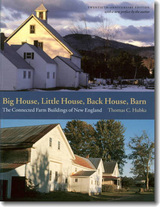
Big House, Little House, Back House, Barn
The Connected Farm Buildings of New England
Thomas C. Hubka
University Press of New England, 2004
“Big house, little house, back house, barn”—this rhythmic cadence was sung by nineteenth-century children as they played. It also portrays the four essential components of the farms where many of them lived. The stately and beautiful connected farm buildings made by nineteenth-century New Englanders stand today as a living expression of a rural culture, offering insights into the people who made them and their agricultural way of life. A visual delight as well as an engaging tribute to our nineteenth-century forebears, this book has become one of the standard works on regional farmsteads in America.
[more]
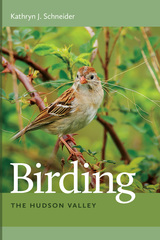
Birding the Hudson Valley
Kathryn J. Schneider
University Press of New England, 2018
Although an estimated four hundred thousand Hudson Valley residents feed, observe, or photograph birds, the vast majority of New Yorkers enjoy their birdwatching activities mostly around the home. Kathryn J. Schneider’s engaging site guide provides encouragement for bird enthusiasts to expand their horizons. More than just a collection of bird-finding tips, this book explores Hudson Valley history, ecology, bird biology, and tourism. It describes sites in every county in the region, including farms, grasslands, old fields, wetlands, orchards, city parks, rocky summits, forests, rivers, lakes, and salt marshes. Designed for birders of all levels of skill and interest, this beautifully illustrated book contains explicit directions to more than eighty locations, as well as useful species accounts and hints for finding the valley’s most sought-after birds.
[more]
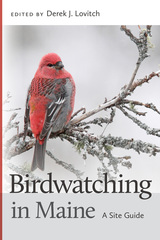
Birdwatching in Maine
A Site Guide
Edited by Derek J. Lovitch
University Press of New England, 2017
With nearly 450 species of birds recorded, Maine offers an abundance of birding opportunities for people of all levels of interest and experience, from those looking beyond their backyards for the first time to knowledgeable visitors looking to plug a hole in their list of sightings. The state’s wealth of undeveloped land and its extensive coastline, countless islands, and varied habitat combine to host an impressive diversity of birds at all times of year. Birders travel to Maine from near and far to seek hard-to-find species, from the only Atlantic Puffins breeding in the United States on offshore islands to Bicknell’s Thrushes high in the mountains. This book fills an important niche for the birdwatching community by offering comprehensive entries detailing the best locations for finding birds throughout the state for enthusiasts of all levels of skill and interest. It contains descriptions of 201 birding sites in Maine, with explicit directions on how to get there, for all sixteen of the state’s counties (several as large as other New England states!). Each chapter features a county map, a brief overview by Derek J. Lovitch, numerous specific site guides, and a list of rarities. The book also contains a detailed and useful species accounts guide for finding the most sought-after birds. Lavishly illustrated in color throughout, Birdwatching in Maine is the best available resource for finding birds in the largest of the New England states. Contributors: Derek Lovitch Kirk Betts Dan Nickerson John Berry Allison Childs Wells Jeffrey V. Wells Herb Wilson Kristen Lindquist Seth Benz Rich MacDonald Ron Joseph Luke Seitz
[more]
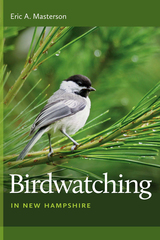
Birdwatching in New Hampshire
Eric A. Masterson
University Press of New England, 2013
Designed to appeal to expert and backyard birdwatchers alike, this comprehensive guide reveals where, when, and how to watch and enjoy birds in New Hampshire. It not only offers the latest information about the seasonal status and distribution of birds in New Hampshire but also features a thorough introduction to the art and practice of birdwatching, including equipment, ethics, migration, conservation, and most of all, finding that “good bird.” The heart of the book is the detailed descriptions and maps that outline more than 120 birding sites across the state, from the Connecticut River Valley to Jeffreys Ledge and Cashes Ledge far off the coast. Drawing upon his extensive knowledge of the habits and habitats of New Hampshire birds, the author has divided the state into six regions, each with a rich diversity of birdwatching destinations. The guide also features informative accounts of the more than 300 bird species regularly seen in the Granite State, including their preferred habitats and graphs illustrating when each is most likely to be encountered. In addition, Masterson also provides a useful guide to rare and accidental bird sightings. The essential guide to birdwatching in New Hampshire for beginners and accomplished regional birders.
[more]
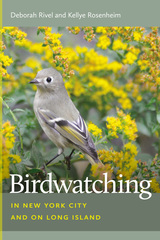
Birdwatching in New York City and on Long Island
Deborah Rivel and Kellye Rosenheim
University Press of New England, 2016
This easy-to-use guide gives seasonal information for both popular birding sites and those off the beaten path. Precise directions to the best viewing locations within the region’s diverse habitats enable birdwatchers to efficiently explore urban and wild birding hotspots. Over 500 species of birds can be seen in New York City’s five boroughs and on Long Island, one of the most densely populated and urbanized regions in North America, which also happens to be situated directly on the Atlantic Flyway. In this fragmented environment of scarce resources, birds concentrate on what’s available. This means that high numbers of birds are found in small spaces. In fact, Central Park alone attracts over 225 species of birds, which birders from around the world flock to see during spring and fall migration. Beyond Central Park, the five boroughs and Long Island have numerous wildlife refuges of extraordinary scenic beauty where resident and migratory birds inhabit forests, wetlands, grasslands, and beaches. These special places present an opportunity to see a wide array of songbirds, endangered nesting shorebirds, raptors, and an unprecedented number and variety of waterfowl. Including the latest information on the seasonal status and distribution of more than 400 species, with 39 maps and over 50 photographs, this full-color guide features information essential to planning a birding visit. It will become the go-to book for both the region’s longtime birders and those exploring the area for the first time.
[more]
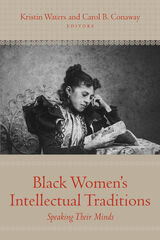
Black Women’s Intellectual Traditions
Speaking Their Minds
Edited by Kristin B. Waters and Carol B. Conaway
University Press of New England, 2007
An astonishing wealth of literary and intellectual work by nineteenth-century black women is being rediscovered and restored to print in scholarly and popular editions. In Kristin Waters’s and Carol B. Conaway’s landmark edited collection, Black Women’s Intellectual Traditions: Speaking Their Minds, sophisticated commentary on this rich body of work chronicles a powerful and interwoven legacy of activism based in social and political theories that helped shape the history of North America. The book meticulously reclaims this American legacy, providing a collection of critical analyses of the primary sources and their vital traditions. Written by leading scholars, Black Women’s Intellectual Traditions is particularly powerful in its exploration of the pioneering thought and action of the nineteenth-century black woman lecturer and essayist Maria W. Stewart, abolitionist Sojourner Truth, novelist and poet Frances Ellen Watkins Harper, educator Anna Julia Cooper, newspaper editor Mary Ann Shadd Cary, and activist Ida B. Wells. The distinguished contributors are Hazel V. Carby, Patricia Hill Collins, Karen Baker-Fletcher, Kristin Waters, R. Dianne Bartlow, Carol B. Conaway, Olga Idriss Davis, Vanessa Holford Diana, Evelyn Simien, Janice W. Fernheimer, Michelle N. Garfield, Joy James, Valerie Palmer-Mehta, Carla L. Peterson, Marilyn Richardson, Evelyn M. Simien, Ebony A. Utley, Mary Helen Washington, Melina Abdullah, and Lena Ampadu. The volume will interest scholars and readers of African-American and women’s studies, history, rhetoric, literature, poetry, sociology, political science, and philosophy.
[more]
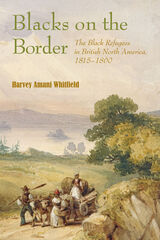
Blacks on the Border
The Black Refugees in British North America, 1815–1860
Harvey Whitfield
University Press of New England, 2006
Following the American Revolution, free black communities and enslaved African Americans increasingly struggled to reconcile their African heritage with their American home. This struggle resulted in tens of thousands of African Americans seeking new homes in areas as diverse as Haiti and Nova Scotia. Black refugees arrived in Nova Scotia after the War of 1812 with little in common but their desire for freedom. By 1860, they had formed families, communities, and traditions. Harvey Amani Whitfield’s study reconstructs the lives and history of a sizeable but neglected group of African Americans by placing their history within the framework of free black communities in New England and Nova Scotia during the nineteenth century. It examines which aspects of American and African American culture black expatriates used or discarded in an area that forced them to negotiate the overlapping worlds of Great Britain, the United States, Afro–New England, and the African American Diaspora, while considering how former American slaves understood freedom long before the Civil War.
[more]
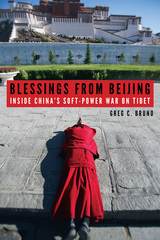
Blessings from Beijing
Inside China's Soft-Power War on Tibet
Greg C. Bruno
University Press of New England, 2018
As we approach the sixtieth anniversary of China’s 1959 invasion of Tibet—and the subsequent creation of the Tibetan exile community—the question of the diaspora’s survival looms large. Beijing’s foreign policy has grown more adventurous, particularly since the post-Olympic expansion of 2008. As the pressure mounts, Tibetan refugee families that have made their homes outside China—in the mountains of Nepal, the jungles of India, or the cold concrete houses high above the Dalai Lama’s monastery in Dharamsala—are migrating once again. Blessings from Beijing untangles the chains that tie Tibetans to China and examines the political, social, and economic pressures that are threatening to destroy Tibet’s refugee communities. Journalist Greg Bruno has spent nearly two decades living and working in Tibetan areas. Bruno journeys to the front lines of this fight: to the high Himalayas of Nepal, where Chinese agents pay off Nepali villagers to inform on Tibetan asylum seekers; to the monasteries of southern India, where pro-China monks wish the Dalai Lama dead; to Asia’s meditation caves, where lost souls ponder the fine line between love and war; and to the streets of New York City, where the next generation of refugees strategizes about how to survive China’s relentless assault. But Bruno’s reporting does not stop at well-worn tales of Chinese meddling and political intervention. It goes beyond them—and within them—to explore how China’s strategy is changing the Tibetan exile community forever.
[more]
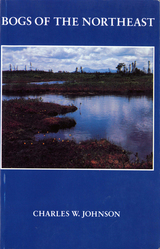
Bogs of the Northeast
Charles W. Johnson
University Press of New England, 1985
What makes bogs so interesting yet so misunderstood? This generously illustrated book presents many of the exciting, almost enthralling, facets of bogs--unusual plants, intricate ecological relationships, animals, myths and folklore, and the myriad history recorded in the peats. Despite the fascinating bogs hold, until now there has been no popular book that deals with them in a comprehensive yet authoritative manner. The Northeastern United States has a wonderful diversity of bogs: some are southern in nature, others are very arctic, and still others maritime. And although this is a book primarily about peatlands in New York, New Jersey, Pennsylvania, and the six New England states, it will interest a much wider audience seeking an exciting and attractive approach to these often-neglected areas of our natural heritage.
[more]
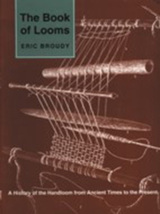
The Book of Looms
A History of the Handloom from Ancient Times to the Present
Eric Broudy
University Press of New England, 1993
A heavily illustrated classic on the evolution of the handloom.
The handloom—often no more than a bundle of sticks and a few lengths of cordage—has been known to almost all cultures for thousands of years. Eric Broudy places the wide variety of handlooms in their historical context. What influenced their development? How did they travel from one geographic area to another? Were they invented independently by different cultures? How have modern cultures improved on ancient weaving skills and methods? Broudy shows how virtually every culture has woven on handlooms. He highlights the incredible technical achievement of early cultures that created magnificent textiles with the crudest of tools and demonstrates that modern technology has done nothing to surpass their skill or inventiveness.
The handloom—often no more than a bundle of sticks and a few lengths of cordage—has been known to almost all cultures for thousands of years. Eric Broudy places the wide variety of handlooms in their historical context. What influenced their development? How did they travel from one geographic area to another? Were they invented independently by different cultures? How have modern cultures improved on ancient weaving skills and methods? Broudy shows how virtually every culture has woven on handlooms. He highlights the incredible technical achievement of early cultures that created magnificent textiles with the crudest of tools and demonstrates that modern technology has done nothing to surpass their skill or inventiveness.
[more]
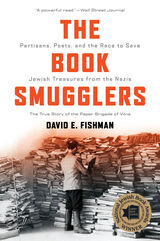
The Book Smugglers
Partisans, Poets, and the Race to Save Jewish Treasures from the Nazis
David E. Fishman
University Press of New England, 2018
The Book Smugglers is the nearly unbelievable story of ghetto residents who rescued thousands of rare books and manuscripts—first from the Nazis and then from the Soviets—by hiding them on their bodies, burying them in bunkers, and smuggling them across borders. It is a tale of heroism and resistance, of friendship and romance, and of unwavering devotion—including the readiness to risk one’s life—to literature and art. And it is entirely true. Based on Jewish, German, and Soviet documents, including diaries, letters, memoirs, and the author’s interviews with several of the story’s participants, The Book Smugglers chronicles the daring activities of a group of poets turned partisans and scholars turned smugglers in Vilna, “The Jerusalem of Lithuania.” The rescuers were pitted against Johannes Pohl, a Nazi “expert” on the Jews, who had been dispatched to Vilna by the Nazi looting agency, Einsatzstab Reichsleiter Rosenberg, to organize the seizure of the city’s great collections of Jewish books. Pohl and his Einsatzstab staff planned to ship the most valuable materials to Germany and incinerate the rest. The Germans used forty ghetto inmates as slave-laborers to sort, select, pack, and transport the materials, either to Germany or to nearby paper mills. This group, nicknamed “the Paper Brigade,” and informally led by poet Shmerke Kaczerginski, a garrulous, street-smart adventurer and master of deception, smuggled thousands of books and manuscripts past German guards. If caught, the men would have faced death by firing squad at Ponar, the mass-murder site outside of Vilna. To store the rescued manuscripts, poet Abraham Sutzkever helped build an underground book-bunker sixty feet beneath the Vilna ghetto. Kaczerginski smuggled weapons as well, using the group’s worksite, the former building of the Yiddish Scientific Institute, to purchase arms for the ghetto’s secret partisan organization. All the while, both men wrote poetry that was recited and sung by the fast-dwindling population of ghetto inhabitants. With the Soviet “liberation” of Vilna (now known as Vilnius), the Paper Brigade thought themselves and their precious cultural treasures saved—only to learn that their new masters were no more welcoming toward Jewish culture than the old, and the books must now be smuggled out of the USSR. Thoroughly researched by the foremost scholar of the Vilna Ghetto—a writer of exceptional daring, style, and reach—The Book Smugglers is an epic story of human heroism, a little-known tale from the blackest days of the war.
[more]
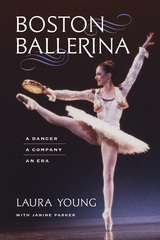
Boston Ballerina
A Dancer, a Company, an Era
Laura Young and Janine Parker
University Press of New England, 2017
As a charter member of Boston Ballet and its predecessor, New England Civic Ballet, Laura Young has been affiliated with the company longer than any other dancer in its history. This book is both a memoir of her personal journey and a fascinating account of Boston Ballet’s rise from a regional troupe to the internationally recognized company that it is today. It is interspersed with ruminations on the history of ballet, stories from the company’s Balanchine-influenced early years under founder E. Virginia Williams, and recollections from noteworthy tours, including those featuring the legendary Rudolf Nureyev, with whom Young was frequently paired. After retiring from the stage, Young has continued her affiliation with Boston Ballet, both as an administrator and a teacher. Working in collaboration with Janine Parker, Young has written a lively, informed, and entertaining memoir.
[more]
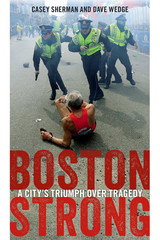
Boston Strong
A City's Triumph over Tragedy
Casey Sherman and Dave Wedge
University Press of New England, 2015
Veteran journalists Casey Sherman and Dave Wedge have written the definitive inside look at the Boston Marathon bombings with a unique, Boston-based account of the events that riveted the world. From the Tsarnaev brothers’ years leading up to the act of terror to the bomb scene itself (which both authors witnessed first-hand within minutes of the blast), from the terrifying police shootout with the suspects to the ultimate capture of the younger brother, Boston Strong: A City’s Triumph over Tragedy reports all the facts—and so much more. Based on months of intensive interviews, this is the first book to tell the entire story through the eyes of those who experienced it. From the cop first on the scene, to the detectives assigned to the manhunt, the authors provide a behind-the-scenes look at the investigation. More than a true-crime book, Boston Strong also tells the tragic but ultimately life-affirming story of the victims and their recoveries and gives voice to those who lost loved ones. With their extensive reporting, writing experience, and deep ties to the Boston area, Sherman and Wedge create the perfect match of story, place, and authors. If you’re only going to read one book on this tragic but uplifting story, this is it.
[more]

Breathe Easy
Relieving the Symptoms of Chronic Lung Disease
Donald A. Mahler
University Press of New England, 2017
Most people don’t think about breathing; it is an automatic, unconscious act. However, the majority of those with asthma (26 million Americans); chronic obstructive pulmonary disease, or COPD (24 million Americans); or interstitial lung disease (1–2 million Americans) are aware of their shortness of breath because it interferes with work or other daily activities. As a result, these individuals seek medical attention for diagnosis and treatment. Breathe Easy, written by a pulmonologist, explains what constitutes normal breathing, what causes someone to feel short of breath, and what can be done to improve one’s breathing. In chapters on asthma, COPD, and interstitial lung disease, Dr. Donald A. Mahler addresses the origins and treatments of these conditions, and offers advice for both standard and alternative therapies to breathe easy. Other chapters describe how we breathe, how to understand respiratory difficulties like chronic shortness of breath, the correct use of inhalers, the effects of aging on the brain and body, and the benefits of exercise. His final chapter provides valuable advice about traveling with oxygen. Illustrated with over fifty enlightening medical graphics, Breathe Easy offers a complete and compact guide for the millions of Americans who are limited by their breathing.
[more]

British Atlantic, American Frontier
Spaces of Power in Early Modern British America
Stephen J. Hornsby
University Press of New England, 2004
Reflecting the growing scholarly interest in transnational and comparative approaches to studying the past, British Atlantic, American Frontier offers a geographical perspective on the development of British America in the seventeenth and eighteenth centuries. It covers in detail not only the American eastern seaboard, but also eastern Canada and the West Indies, as well as the trans-Atlantic links to Western Europe and West Africa. At one level, the book synthesizes much of the current historical and geographical scholarship on these regions; at another level, it offers a provocative interpretation of British America, arguing that profound and long-standing differences existed between the American eastern seaboard and the Atlantic regions of eastern Canada and the West Indies. These differences ultimately led to the break-up of British America, the creation of the United States, and the reconfiguration of the British Empire. British Atlantic, American Frontier is illustrated with more than one hundred photographs, maps, and historical illustrations.
[more]

A Building History of Northern New England
James L. Garvin
University Press of New England, 2002
This is a book about understanding old buildings. In an era in which much of the US landscape has been littered by unimaginative, prefabricated structures, James L. Garvin tells owners and would-be owners of old buildings in Maine, New Hampshire, and Vermont what they need to know before they begin the restoration process. In wonderfully lucid prose, Garvin describes the production of the materials from which the buildings of northern New England were built, outlines the stylistic evolution of the region's structures from the early 1700s to World War II, and offers guidelines for dating old buildings. Focusing on domestic architecture, but including examples of public, commercial, religious, and industrial buildings, he offers custodians of buildings an understanding of the technologies embodied in these structures, answers questions about stylistic changes, and allows the architecture of northern New England to be understood for the first time with a technical depth that is already available for buildings in better-studied parts of the US. Written for both homeowners and those responsible for public and museum structures, this volume provides an understanding of the region's building history even as it specifically answers questions that most often perplex architects and preservationists. By offering all custodians of northern New England buildings a richer understanding of architectural style and structure, the book encourages the use of appropriate methods and materials in building conservation and rehabilitation. Generously illustrated throughout, the book is also an essential resource for anyone who is interested in American and New England architecture and the building trades, and for anyone who has ever wondered about the secrets and stories of old buildings.
[more]
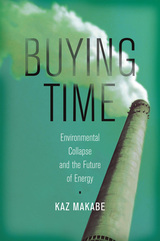
Buying Time
Environmental Collapse and the Future of Energy
Kaz Makabe
University Press of New England, 2017
WE KNOW, from repeated failures to predict and prevent catastrophes ranging from the Great Tohoku Earthquake to the global financial crisis of 2008, that complex adaptive systems, such as those found in nature or in economies, are actually very hard to predict, much less influence. Today, we face environmental degradation caused in large part by the use of fossil fuels, ever-declining efficiencies in extracting them, a pace of development for renewable energy insufficient for replacement of the fossil fuels we are burning through, and population growth that is likely to add two billion people globally by 2045. Despite partial recovery since the financial crisis of 2008, growth remains sluggish, and large budget deficits persist across much of the developed world. Meanwhile, developing states face their own challenges, stemming from unbalanced growth. Against this backdrop, and in light of the urgent need to pay closer heed to our environment, the last thing the world needs is an energy crisis triggered not merely by recurrent scares over supply, but by more lasting structural changes in our ability to use fossil fuels with reckless abandon. Buying Time applies lessons learned the hard way from the global economic crisis of the past decade, to offer an overview of the state of the environment and our energy future. Grounded in subtle thinking about complex systems, including the economy, energy, and the environment, this book underscores the connections linking them all. Kaz Makabe is a veteran financial systems expert who lived through the Fukushima Daiichi nuclear disaster. He nevertheless concludes that nuclear energy is the bridge than can help us cross over the abyss we face.
[more]
READERS
Browse our collection.
PUBLISHERS
See BiblioVault's publisher services.
STUDENT SERVICES
Files for college accessibility offices.
UChicago Accessibility Resources
home | accessibility | search | about | contact us
BiblioVault ® 2001 - 2024
The University of Chicago Press









